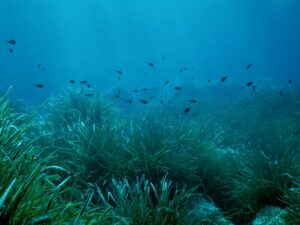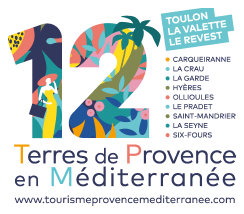Few people have a positive thought when they first discover these “piles of seaweed” abandoned on the beach… Their reaction is often a sense of disgust or annoyance at the cleaning services for not cleaning up these “horrors”. And yet you have to learn to cherish the posidonia, which are far from what you might imagine at first glance.
First of all, posidonia is not seaweed, but an underwater grass. Underwater, we talk about meadows, or even forests of posidonia. It is an endemic plant: you will only come across it in the Mediterranean. The leaves can be up to 1 metre long and 1 centimetre wide.
Posidonia plays a central role for underwater life and shorelines
It is found stranded on beaches in winter, forming a mass that can reach several tens of centimetres, forming a “bank”, posidonia grows on the edges of beaches, in shallow water. It can be found at a depth of up to 40 metres, the last threshold for capturing the sunlight necessary for it to develop.
The posidonia, which form banks, protect the coastline from erosion
Posidonia are extremely effective in combating the disappearance of beaches. Without them, the sand would be washed away by the waves. They act as a shock absorber when waves hit the shore and prevent sand from being dispersed into the sea. Maintaining the posidonia on the beaches is in everyone’s interest.

Posidonia forests are the guardians of the marine ecosystem
Spawning grounds, nurseries, larders: Posidonia meadows are essential for the maintenance and development of underwater life. More than 1,000 underwater species are found here, including shellfish and fish such as sea urchins, wrasses, red mullets, etc. Posidonia forests act as a spawning ground where juveniles (young fish) grow up in safety, and it watches over underwater life in the Mediterranean.
Posidonia also have a tremendous impact on the Mediterranean: also known as the “lungs of the Mediterranean”, posidonia produce oxygen (through photosynthesis) in a volume that can be greater per square metre than that produced by the Amazon forest.

Posidonia : an emblem of the Mediterranean
Despite its unappealing appearance, it is essential to ensure the conservation of posidonia on the beaches as well as underwater.
Once the “surprise” is over, what a joy it is to walk on the posidonia banks and to discover their very soft bouncing effect. Children are not mistaken: you will certainly come across them doing improbable jumps and rolls between two mounds !
Underwater, the Posidonia meadows are the ideal observation ground during snorkelling trips. And what a view! Seeing the sun filtering through the grass, in the underwater relief, is poetry.
To find out more about the posidonia and the small things you can do to protect it, go to the Calanques National Park page dedicated to them
Photo credit :
Office de Tourisme Provence Méditerranée / Robert Palomba
Parc national de Port-Cros / Muriel Gasquy
Parc national de Port-Cros / Philippe Robert







